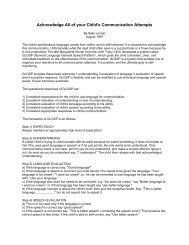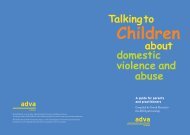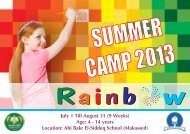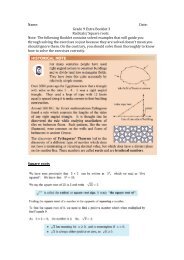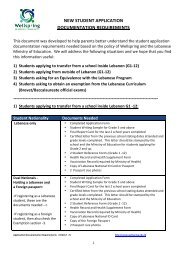Nurturing Giftedness in Young Children - Wellspring Learning ...
Nurturing Giftedness in Young Children - Wellspring Learning ...
Nurturing Giftedness in Young Children - Wellspring Learning ...
Create successful ePaper yourself
Turn your PDF publications into a flip-book with our unique Google optimized e-Paper software.
<strong>Nurtur<strong>in</strong>g</strong> <strong>Giftedness</strong> <strong>in</strong> <strong>Young</strong> <strong>Children</strong><br />
ERIC Digest #E487 1990<br />
Author: Wendy C. Roedell<br />
Versions of the follow<strong>in</strong>g conversation can often be heard when young gifted children start school. "Bill<br />
doesn't belong <strong>in</strong> k<strong>in</strong>der-garten!" the parent cries. "Look, he's read<strong>in</strong>g at the fourth-grade level and has<br />
already learned two-column addition." The teacher or pr<strong>in</strong>cipal, hav<strong>in</strong>g already decided this is a 'pushy<br />
parent,' replies, "Well, Mrs. Smith, Bill certa<strong>in</strong>ly doesn't belong <strong>in</strong> first grade; he hasn't learned to tie his<br />
shoelaces, and he can't hold a pencil properly, and he had a tantrum yesterday <strong>in</strong> the hall."<br />
The problem <strong>in</strong> this cont<strong>in</strong>u<strong>in</strong>g controversy is that both par- ties are usually correct. Some gifted children<br />
enter<strong>in</strong>g k<strong>in</strong>der- garten have acquired academic skills far beyond those of their age mates. Such children<br />
master the academic content of k<strong>in</strong>dergarten when they are 3 years old. However, their physical and<br />
social development may be similar to that of other 5-year- olds, mak<strong>in</strong>g an accelerated placement a<br />
mismatch as well. The usual solution is to place a child like Bill <strong>in</strong> a program matched to his weaknesses,<br />
rather than to his strengths. Bill usually ends up <strong>in</strong> k<strong>in</strong>dergarten, where his advanced <strong>in</strong>tellectual<br />
development be- comes a frustration to his teacher, an embarrassment to his peers, and a burden to Bill.<br />
Educators justify this placement by say<strong>in</strong>g, "Bill needs so- cialization; he's already so far ahead<br />
academically, he doesn't need anyth<strong>in</strong>g <strong>in</strong> that area." There are two major problems with this rationale.<br />
First, educators are essentially tell<strong>in</strong>g such stu- dents that there is no need for them to learn anyth<strong>in</strong>g <strong>in</strong><br />
school. The second problem is revealed by exam<strong>in</strong><strong>in</strong>g the so called "socialization" experienced by a<br />
brilliant 5-year-old like Bill <strong>in</strong> a k<strong>in</strong>dergarten class of 25 to 30 students. A major component of early<br />
socialization <strong>in</strong>volves a child's feel<strong>in</strong>g that she or he is ac- cepted by othersQteachers and children alike.<br />
If the teacher does not validate a gifted child's advanced abilities and <strong>in</strong>tellec- tual <strong>in</strong>terests by mak<strong>in</strong>g<br />
them part of the ongo<strong>in</strong>g curriculum, the child experiences no feel<strong>in</strong>gs of acceptance from the teacher. If,<br />
as is highly likely, this child makes the additional discovery that she or he is quite different from most<br />
classmates and that com- munication is extremely difficult because of differences <strong>in</strong> vo- cabulary and<br />
modes of expression, then the child misses peer acceptance as well. In fact, this first school experience,<br />
which should furnish the impetus for future enthusiasm about learn<strong>in</strong>g, can be a dismal failure for the<br />
brilliant child <strong>in</strong> a lockstep k<strong>in</strong>der- garten program. Often these children learn to hide or deny their<br />
abilities, so as to fit <strong>in</strong> better with the other children. Or, they may develop behavioral problems or<br />
psychosomatic symptoms such as stomachaches and headaches, caus<strong>in</strong>g parents to confront the school<br />
with justifiable concern.<br />
Understand<strong>in</strong>g Uneven Development<br />
It is important to remember that these children very often do not develop evenly. In fact, young gifted<br />
children frequently show peaks of extraord<strong>in</strong>ary performance rather than equally high skill levels <strong>in</strong> all<br />
cognitive areas. The child who learns to read at age 3 or who shows unusually advanced spatial<br />
reason<strong>in</strong>g ability, for example, may not be the child with the highest IQ or the earliest language<br />
development. Unique patterns of development can be observed with<strong>in</strong> a group of gifted children, and<br />
uneven develop- ment is frequently evident <strong>in</strong> the pattern of a s<strong>in</strong>gle child. In some cases, it seems as<br />
though children's abilities develop <strong>in</strong> spurts, guided by changes <strong>in</strong> <strong>in</strong>terest and opportunity. Read<strong>in</strong>g<br />
ability, for example, might develop almost overnight. <strong>Children</strong> who know all their letters and letter sounds<br />
by age 2 1/2 may rema<strong>in</strong> at that level for some time, perhaps until age 4 or 5, and then <strong>in</strong> a matter of<br />
months develop fluent read<strong>in</strong>g skills at the third or fourth grade level.<br />
Another area of unevenness <strong>in</strong> the development of gifted young children is found <strong>in</strong> the relationship<br />
between advanced <strong>in</strong>- tellectual development and development of physical and social skills. Evidence<br />
seems to <strong>in</strong>dicate that <strong>in</strong>tellectually gifted chil- dren's performance <strong>in</strong> the physical doma<strong>in</strong> may only be<br />
advanced to the extent that the physical tasks <strong>in</strong>volve cognitive organiza- tion. And, although <strong>in</strong>tellectually
advanced children tend to pos- sess some advanced social-cognitive skills, they do not neces- sarily<br />
demonstrate those skills <strong>in</strong> their social behavior. In other words, they may understand how to solve social<br />
conflicts and <strong>in</strong>- teract cooperatively, but not know how to translate their under- stand<strong>in</strong>g <strong>in</strong>to concrete<br />
behavior.<br />
It is not uncommon to f<strong>in</strong>d gifted young children experienc<strong>in</strong>g a vast gap between their advanced<br />
<strong>in</strong>tellectual skills and their less advanced physical and emotional competencies. For exam- ple, 4- and 5year<br />
old children may converse <strong>in</strong>telligently about abstract concepts such as time and death and read<br />
fluently at the fourth-grade level, yet f<strong>in</strong>d it difficult to hold a pencil or to share their toys with others.<br />
Often these uneven developmental levels can lead to ex- treme frustration, as children f<strong>in</strong>d that their<br />
limited physical skills are not sufficiently developed to carry out the complex projects they imag<strong>in</strong>ed.<br />
These children may throw tantrums or even give up on projects without try<strong>in</strong>g. Adult guidance <strong>in</strong><br />
develop<strong>in</strong>g cop<strong>in</strong>g strategies can help such children set more realistic goals for themselves and learn how<br />
to solve problems effectively when their orig<strong>in</strong>al efforts do not meet their high expectations.<br />
Adults, too, can be misled by children's advanced verbal ability or reason<strong>in</strong>g skill <strong>in</strong>to expect<strong>in</strong>g equally<br />
advanced behavior <strong>in</strong> all other areas. It is unsettl<strong>in</strong>g to hold a high-level conversation with a 5 year-old<br />
who then turns around and punches a classmate who stole her pencil. Sometimes young children's ageappropri-<br />
ate social behavior is <strong>in</strong>terpreted as willful or lazy by parents and teachers whose expectations<br />
are unrealistically high. The only accurate generalization that can be made about the characteris- tics of<br />
<strong>in</strong>tellectually gifted young children is that they demonstrate their unusual <strong>in</strong>tellectual skills <strong>in</strong> a wide<br />
variety of ways and that they form an extremely heterogeneous group with respect to <strong>in</strong>- terests, skill<br />
levels <strong>in</strong> particular areas, social development, and physical abilities.<br />
Understand<strong>in</strong>g the unique developmental patterns often pre- sent <strong>in</strong> gifted children can help parents, and<br />
teachers as well, ad- just their expectations of academic performance <strong>in</strong> young children to a more<br />
reasonable level.<br />
Choos<strong>in</strong>g a Program or School<br />
One of the few psychological truths educators and psychologists agree upon states that the most learn<strong>in</strong>g<br />
occurs when an optimal match between the learner's current understand<strong>in</strong>g and the chal- lenge of new<br />
learn<strong>in</strong>g material has been carefully eng<strong>in</strong>eered. Choos<strong>in</strong>g a program or school for a gifted child who<br />
masters ideas and concepts quickly but who behaves like a typical 4- or 5-year- old is <strong>in</strong>deed a challenge.<br />
Many <strong>in</strong>tellectually gifted children master the cognitive con- tent of most preschool and k<strong>in</strong>dergarten<br />
programs quite early. They come to school ready and eager to learn concepts not usu- ally taught until an<br />
older age. However, academic tasks designed for older children often require the learner to carry out<br />
teacher-di- rected activities while sitt<strong>in</strong>g still and concentrat<strong>in</strong>g on written work sheets. <strong>Young</strong> children, no<br />
matter how bright they are, re- quire active <strong>in</strong>volvement with learn<strong>in</strong>g materials and often do not have the<br />
writ<strong>in</strong>g skills required for above-grade-level work.<br />
S<strong>in</strong>ce many gifted children will hide their abilities so as to fit <strong>in</strong> more closely with classmates <strong>in</strong> a regular<br />
program, teachers may not be able to observe advanced <strong>in</strong>tellectual or academic abilities directly. If a<br />
k<strong>in</strong>dergartner enters school with fluent read<strong>in</strong>g abil- ity, the parent should share this <strong>in</strong>formation at the<br />
beg<strong>in</strong>n<strong>in</strong>g of the year <strong>in</strong>stead of wait<strong>in</strong>g until the end of the year to compla<strong>in</strong> that the teacher did not f<strong>in</strong>d<br />
out that the child could read. When parents and teachers pool their observations of a child's skills, they<br />
beg<strong>in</strong> to work together to develop appropriate educational options for nurtur<strong>in</strong>g those abilities. Parents<br />
whose children have some unusual characteristics that will affect their learn<strong>in</strong>g needs have an obligation<br />
to share that <strong>in</strong>formation with educators, just as educators have an obligation to listen carefully to parent<br />
concerns.
When the entry level of learners is generally high but ex- tremely diverse, an appropriate program must<br />
be highly <strong>in</strong>dividual- ized. <strong>Children</strong> should be encouraged to progress at their own learn<strong>in</strong>g rate, which will<br />
result <strong>in</strong> most cases <strong>in</strong> subject matter ac- celeration. The program should be broadly based, with planned<br />
opportunities for development of social, physical, and cognitive skills <strong>in</strong> the <strong>in</strong>formal atmosphere of an<br />
early childhood classroom.<br />
One primary task of teachers is to make appropriately ad- vanced content accessible to young children,<br />
tak<strong>in</strong>g <strong>in</strong>to account <strong>in</strong>dividual social and physical skills. Lessons can be broken <strong>in</strong>to short units, activities<br />
presented as games, and many concepts taught through <strong>in</strong>quiry-oriented dialogue and experimentation<br />
with manipulatable materials. Language experience activities <strong>in</strong> read- <strong>in</strong>g and the use of manipulatable<br />
math materials as described <strong>in</strong> products like Mathematics Their Way (Baratta-Lorton, 1976), are good<br />
examples of appropriate curriculum approaches.<br />
An appropriate learn<strong>in</strong>g environment should also offer a gifted young child the opportunity to discover true<br />
peers at an early age. Parents of gifted children frequently f<strong>in</strong>d that, while their child can get along with<br />
other children <strong>in</strong> the neighborhood, an <strong>in</strong>tense friendship is likely to develop with a more developmentally<br />
equal peer met <strong>in</strong> a special class or <strong>in</strong>terest-based activity. Such par- ents may be dismayed to discover<br />
that this "best friend" does not live next door but across town, and may wonder whether or not to give <strong>in</strong> to<br />
their child's pleas for <strong>in</strong>convenient visits. Probably one of the most supportive activities a parent can<br />
engage <strong>in</strong> is to help a child f<strong>in</strong>d a true friend and make the effort required to permit the friendship to<br />
flower.<br />
In look<strong>in</strong>g for an appropriate program for their gifted preschooler, then, parents must be aware of the<br />
learn<strong>in</strong>g needs of young children and not be misled by so-called experts who advo- cate rigid academic<br />
approaches with an emphasis on rote memo- rization and repetition. Rather wise parents will look for<br />
open- endedness, flexible group<strong>in</strong>g, and opportunities for advanced ac- tivities <strong>in</strong> a program that allows<br />
their child to learn <strong>in</strong> the company of <strong>in</strong>tellectual peers.<br />
RESOURCES<br />
Allen, R. V., & Allen, C. (1970). Language experiences <strong>in</strong> read<strong>in</strong>g (Vols.1 & 2). Chicago: Encyclopedia<br />
Britannica Press.<br />
Baratta-Lorton, M. (1976). Mathematics their way: An activity center mathematics program for early<br />
childhood education. Menlo Park, CA: Addison-Wesley.<br />
Roedell, W. C. (1989). Early development of gifted children. In VanTassel-Baska, J. & Olszewski-Kubilius,<br />
P. (Eds.), Patterns <strong>in</strong>fluence on gifted learners (pp.13-28). New York: Teachers College Press.<br />
Roedell, W. C., Jackson, N. E., & Rob<strong>in</strong>son, H. B. (1980). Gifted young children. New York: Teachers<br />
College Press.<br />
Spivack, G., & Shure, M. B. (1974). Social adjustment of young children. San Francisco: Jossey-Bass.<br />
Additional Read<strong>in</strong>g<br />
Smutny, J. F., Veenker, K., Veenker, S. (1989). Your gifted child: How to recognize and develop the<br />
special talents <strong>in</strong> your child from birth to age seven. A practical source book conta<strong>in</strong><strong>in</strong>g a wealth of<br />
<strong>in</strong>formation for parents and educators of young gifted children. Leads parents through <strong>in</strong>fancy and early<br />
childhood, discuss<strong>in</strong>g topics such as language development, creativity, and how to choose schools.<br />
Provides a developmental checklist. New York: Facts On File. Also available from The Council for<br />
Exceptional <strong>Children</strong>/ The ERIC Clear<strong>in</strong>ghouse on Disabilities and Gifted Education.
Wendy C. Roedell, Ph.D., is Director of the Early Childhood Education and Assistance Program at Educational Service District 121<br />
<strong>in</strong> Seattle, Wash<strong>in</strong>gton and senior author of Gifted <strong>Young</strong> <strong>Children</strong>.<br />
Note. Adapted by permission of the publisher from VanTassel- Baska, Joyce L. and Olszewski-Kubilius, Paula, Early develop- ment<br />
of gifted children by Wendy C. Roedell from Patterns of <strong>in</strong>- fluence on gifted learners, The home, the self, and the school. (New<br />
York: Teachers College Press, ) 1989 by Teachers College, Columbia University, pp. 13-28, All rights reserved)<br />
ERIC Digests are <strong>in</strong> the public doma<strong>in</strong> and may be freely reproduced and dissem<strong>in</strong>ated, but please<br />
acknowledge your source. This publication was prepared with fund<strong>in</strong>g from the U.S. Department of<br />
Education, Office of Educational Research and Improvement, under contract no. RI93002005. The<br />
op<strong>in</strong>ions expressed <strong>in</strong> this report do not necessarily reflect the positions or policies of OERI or the<br />
Department of Education.<br />
The ERIC Clear<strong>in</strong>ghouse on Disabilities and Gifted Education (ERIC EC)<br />
The Council for Exceptional <strong>Children</strong><br />
1920 Association Drive<br />
Reston, VA 20191<br />
Toll Free: 1.800.328.0272<br />
TTY: 703.264.9449<br />
E-mail: ericec@cec.sped.org<br />
Internet: http://ericec.org/



